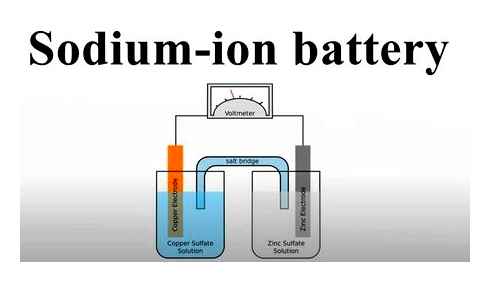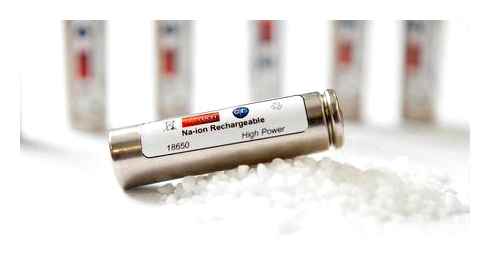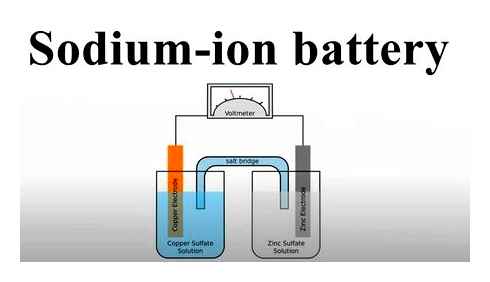How sodium could change the game for batteries
Over the past couple of months, I’ve been noticing a lot of announcements about a new type of battery, one that could majorly shake things up if all the promises I’m hearing turn out to be true.
Don’t settle for half the story. Get paywall-free access to technology news for the here and now.
MIT Technology Review provides an intelligent and independent filter for the flood of information about technology.
The new challenger? Sodium-ion batteries, which swap sodium for the lithium that powers most EVs and devices like cell phones and laptops today.
Sodium-ion batteries could squeeze their way into some corners of the battery market as soon as the end of this year, and they could be huge in cutting costs for EVs. I wrote a story about all the recent announcements, and you should give it a read if you’re curious about what companies are jumping in on this trend and what their plans are. But for the newsletter this week, let’s dig a little bit deeper into the chemistry and consider what the details could mean for the future of EV batteries.
Top dog
One of the reasons that lithium dominates batteries today is absolutely, maddeningly simple: it’s small.
I mean that in the most literal, atomic sense. Lithium is the third-lightest element, heavier than only hydrogen and helium. When it comes down to it, it’s hard to beat the lightest metal in existence if you’re trying to make compact, lightweight batteries.
And cutting weight and size is the goal for making everything from iPhones to EVs: a lightweight, powerful battery means your phone can be smaller and your car can drive farther. So one of the primary ways we’ve measured progress for batteries is energy density—how much energy a battery can pack into a given size.
When you look at that chemical reality, it’s almost no wonder that lithium-ion batteries have exploded in popularity since their commercial debut in the 1990s. There are obviously other factors too, like lithium-ion’s ability to reach high voltages in order to deliver a lot of power, but the benefit of being lightweight and portable is hard to overstate.
Lithium-ion batteries have also benefited from being the incumbent. There are countless researchers scouring the world for new materials and new ways to build lithium-ion cells, and plenty of companies making them in greater numbers—all of which adds up to greater efficiencies. As a result, costs have come down basically every year for decades (with the notable exception of 2022).
And at the same time, energy density is ticking up, a trend I’m personally grateful for because I often forget to charge my phone for days at a time, and it typically works out much better when that happens now than it did a few years ago.
Branching out
But just because lithium-ion dominates the battery world today doesn’t mean it’ll squash the competition forever.
I’ve written about the growing number of options in the battery industry before, mostly in the context of stationary storage on the electrical grid. This is especially important in the transition to intermittent renewable energy sources like wind and solar.
While backup systems tend to use lithium-ion batteries today since they’re what’s available, many companies are working to build batteries that could eventually be even cheaper and more robust. In other words, many researchers and companies want to design batteries specifically for stationary storage.
New batteries could be made with abundant materials like iron or plastic, for example, and they might use water instead of organic solvents to shuttle charge around, addressing lingering concerns about the safety of large-scale lithium-ion battery installations.
But compared to stationary storage, there are fewer candidates that could work in EV batteries, because of the steep demands we have for our vehicles. Today, most of the competition in the commercial market is between the different flavors of lithium-ion batteries, with some lower-cost versions that don’t contain cobalt and nickel gaining ground in the last couple of years.

That could change soon too, though, because just below lithium on the periodic table, a challenger lurks: sodium. Sodium is similar to lithium in some ways, and cells made with the material can reach similar voltages to lithium-ion cells (meaning the chemical reactions that power the battery will be nearly as powerful).
And crucially, sodium-based batteries have recently been cramming more energy into a smaller package. In 2022, the energy density of sodium-ion batteries was right around where some lower-end lithium-ion batteries were a decade ago—when early commercial EVs like the Tesla Roadster had already hit the road.
Projections from BNEF suggest that sodium-ion batteries could reach pack densities of nearly 150 watt-hours per kilogram by 2025. And some battery giants and automakers in China think the technology is already good enough for prime time. For more on those announcements and when we might see the first sodium-battery-powered cars on the road, check out my story on the technology.
Related reading
I wrote about the potential for this sort of progress in a story from January about what we might see for batteries this year.
Take a tour of some other non-lithium-based batteries:
- Iron-based batteries could be a cheap way to store energy on the grid and assuage concerns about safety.
- What about using plastic instead?
- Some companies want to go beyond batteries entirely to store energy.
New breakthrough in sodium-ion battery: Why it could be a boon for EV industry
Even while electric vehicles are taken to be green options (as opposed to petroleum-based vehicles), there has been some valid concern over the the nature of batteries being used in the EVs. The most popular one, Li-ion battery pack. let us face it. is not the most eco-friendly one.
The clean energy brigade is, however, working on newer battery techs that would be less hazardous on the environment. Sodium-ion battery has emerged to be the most popular, as it is less expensive and more green in its quintessence.
Sodium is abundant and cheap, but its limited performance in battery has hitherto hindered its large-scale application. But now a breakthrough is being claimed by a research team from the Department of Energy’s Pacific Northwest National Laboratory (PNNL). It claims to have developed a sodium-ion battery with greatly extended longevity in laboratory tests. The findings provide a promising recipe for the battery’s use in the EV industry and also store energy from the sun.
Explained: The new sodium-ion battery tech
In a statement, PNNL, quoting the research lead Jiguang Zhang, a pioneer of battery technologies with more than 23 patented inventions in energy storage technology, said: we have shown in principle that sodium-ion batteries have the potential to be a long lasting and environmentally friendly battery technology.
In general, as a battery goes through repeated cycles of charging and discharging, it loses its ability to hold charge. In current sodium-ion battery technologies, this process happens much faster than in similar lithium-ion batteries.
But the new sodium-ion battery technology developed at PNNL holds its ability to charge for longer than previously described sodium-ion batteries.
The scientists reportedly pulled this off by changing the cathode material and adding a totally different charge carrier (which is deemed the electrolyte, the ‘blood’ that keeps the energy flowing in a battery). By smartly tweaking the ingredients that make up the liquid core of the battery, the scientists were able to prevent the performance issues that have bedevilled sodium-based batteries.
The new ‘electrolyte’ also generates an ultra-thin protective layer on the positive pole (the cathode) that contributes to additional stability of the entire unit.
Sodium-ion battery and EV industry
In laboratory tests, the new design proved durable, holding 90 percent of its cell capacity after 300 cycles at 4.2 V, which is higher than most sodium-ion batteries previously reported, PNNL said.
The new sodium-ion technology also uses a naturally fire-extinguishing solution that is also impervious to temperature changes and can operate at high voltages.
Even now, the sodium-ion technology still lags behind lithium in energy density. But its stability in the face of temperature changes, and long cycle life, surely make it attractive for the EV industry, especially for light-duty EVs and even grid energy storage.
Sodium-ion cells may not immediately overtake traditional lithium-ion batteries, but they do present a number of benefits for charging, maintaining energy, and helping to promote cleaner energy.
For the record, last year, global battery major CATL introduced its first-generation sodium-ion battery, as well as an AB solution that integrates both sodium-ion and lithium-ion cells into one pack.
In India, Reliance Industries has announced the acquisition of UK-based Faradion, a company working on use of sodium ions in rechargeable batteries.
Sodium-ion batteries from CATL and BYD to be installed in mass-produced cars by Q4 2023
In an exclusive report, local media 36kr informed that CATL would install sodium-ion batteries into the first EVs in the fourth quarter of the year, while BYD will start mass production of sodium-ion packs in the second half and install them on BYD Seagull and other Ocean series models. 36kr media is something like ‘Chinese TechCrunch.’
Both companies will mix lithium-ion and sodium-ion batteries under newly developed BMS in their new mass-produced batteries.
CATL’s sodium-ion battery is set to be incorporated into the initial model of Chery’s iCAR brand of new energy vehicles (NEVs). Chery announced this at their conference last week, but the launch in Q4 is further information. 36kr report also says that sodium ion will be used on Chery’s budget EVs, such as QQ Ice Cream.
Sodium-ion batteries are alternatives to LFP and NMC batteries to ease the dependence on lithium. Its price continued to rise last two years and, at its peak, exceeded 600,000 yuan/ton (87,200 USD).
CATL Sodium-ion
In July 2021, CATL revealed its sodium-ion batteries which possess an energy density of 160Wh/kg, a slightly lower value than LFP batteries. However, these batteries offer certain advantages, such as more cost-effective manufacturing, superior performance in low temperatures, and enhanced safety features. Furthermore, CATL shared that their upcoming sodium-ion batteries, with improved energy density surpassing 200 Wh/kg, will commence mass production by 2023. Common LFP batteries have an energy density of about 90 – 160 Wh/kg.
CATL first-generation sodium-ion cells cost about 77 USD per kWh, and the second generation with volume production can drop to 40 USD per kWh.
In present times, it appears reasonable to utilize sodium-ion batteries in electric vehicles. However, this was not an obvious choice back in 2021 when even CATL believed that sodium-ion batteries would mainly be suitable for energy storage and two-wheeled scooters. Some analysts in China went as far as speculating that the CATL sodium-ion battery initiative was only meant to exert pressure on lithium suppliers to lower the prices.

Nevertheless, the progress in developing sodium-ion batteries surpassed expectations, while lithium continued to surge throughout 2022. As a result, it became increasingly evident that utilizing sodium-ion batteries in electric vehicles was inevitable. In November 2022, CATL confirmed this development, announcing that their sodium-ion batteries are anticipated to power electric vehicles.
BYD Sodium-ion
There are others besides CATL who are driving the advancement of sodium-ion batteries. Last December, BYD announced their plans to commence mass production in 2023 and introduce a compact electric hatchback powered by a sodium-ion battery pack. CarNewsChina reported that this car is most likely to be the BYD Seagull, which was launched two days ago at Shanghai Auto Show. However, without the sodium-ion battery pack option. 36kr report now reveals that the Seagull variant with sodium-in will come in the second half of the year, and it should have a 305 km CLTC range. The Seagull price starts at about 80,000 yuan (11,600 USD).
As per SNE research, CATL is the largest battery manufacturer in the world, commanding a global market share of 37% in 2022. LG and BYD follow with 13.6% each. Virtually all notable electric vehicle manufacturers are clients of CATL, which includes Tesla, Volkswagen, Nissan, Nio, and Tata. over, CATL is also an integral part of the recently constructed Ford battery plant in the United States.
Benefits of sodium-ion batteries:

- Safer than lithium batteries
- Better ability to withstand cold temperatures
- Slower discharge rate
- Cheaper to produce
- Better for the environment
But there are still some disadvantages:

Edit: The article mentioned the wrong common energy density of LFP batteries and was updated with the correct value (90 – 160 Wh/kg).
The First Sodium-ion Battery EV
Hina Battery, a Beijing-based startup, and Sehol, a joint venture brand between JAC and Volkswagen Anhui, have jointly built a test vehicle with sodium-ion batteries based on the latter’s Sehol E10X model.
The test vehicle has a battery pack with a capacity of 25 kWh and an energy density of 120 Wh/kg. The model has a range of 252 km and supports fast charging of 3C to 4C. The battery pack uses cells with an energy density of 140 Wh/kg. For comparison, the regular version of the Sehol E10X has two pack capacities, 19.7 kWh and 31.4 kWh, with a range of 200 km and 302 km, respectively. The higher capacity pack has an energy density of 141 Wh/kg.
In addition, Hina Battery officially launched three sodium-ion battery cells with energy densities of 140 Wh/kg, 145 Wh/kg and 155 Wh/kg respectively. The company plans to penetrate the EV market with its disrupting Na-ion battery technology as it is extending cooperation with several EV companies and offering its products for use in two-wheelers, passenger cars, commercial vehicles, home and commercial and commercial and industrial energy storage, and large-scale energy storage.
“We judge that the application of sodium-ion batteries in the new energy vehicle market will start with the A00-class EVs, which is why we chose a model like the Sehol E10X for our installation trials,” a post on Sehol’s official WeChat account quoted words of a company executive.
Why Sodium-ion Batteries?
The Sodium-ion (Na-ion) battery is a fast-evolving, cheaper, portable, and efficient storage solution. The Na-ion batteries have a lower density than their lithium-ion counterparts. In addition, Na-ion batteries offer superior environmental credentials, enhanced safety (Na-ion battery is non-flammable), and better raw material costs than lithium-ion (Li-ion) – Sodium is abundant compared to lithium, with the overall cost of extraction and purification far lower. It is mostly extracted from seawater, and ashes of plants growing in sodium-rich soils.
A Sodium-ion battery could be a lot cheaper than Li-ion. As per media reports, Na-ion cells are quoted to be between 20 per cent and 40 per cent cheaper. Notably, using Sodium is also environment-friendly. However, in the short term, the cost to manufacture Na-ion is expected to be high as producers look to reach scaled production in the mid-2020s.
The technology is still in its infancy and marred with the challenge of bringing it to scale. Nevertheless, sodium ion technology is a strong alternative to existing lithium-ion technology. With rising problems of Lithium unavailability and development in the technology, Na-ion may soon be around just like Lithium-ion batteries of present times.
Rising Tide of Na-ion
Several firms across the globe are developing sodium-ion batteries, including the Chinese lithium-ion battery giant CATL. CATL unveiled its first sodium-ion battery in July 2021 and also plans to begin commercial production in 2023. The Indian heavyweight Reliance bought sodium-ion battery start-up Faradion for 135 million, which boosted the likelihood of battery commercialisation soon. Faradion was one of the early movers to Champion Na-ion battery technology more than 10 years ago and had no competition back then.
In November last year, Yiche cited a conference call that said BYD’s Seagull will likely be the first to carry sodium-ion batteries, with the model’s launch expected in the second quarter of 2023.
Junaid Shah
Junaid holds a Master of Engineering degree in Construction Management. Being a civil engineering postgraduate and using his technical prowess, he has channeled his passion for writing in the environmental niche.
